Beam Dialog Box | ||||
|
| |||
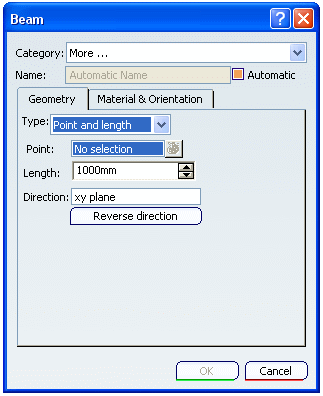
Category
Select the appropriate category from the Category list.
To select the category defined in the Project Dictionary Resource set in Project Resource Management, select More in the Category list. The Types Browser Dialog Box appears.
![]()
Name
The name is assigned automatically, using the object naming rules. If you want to assign a specific name, clear the Automatic check box and type the name in the Name box.
![]()
Geometry
- Type
- In the Type box, select the appropriate type for creating a beam. Available options are:
![]()
Point and Length
- Point
- Select points where you want to create beams which appear in the Point box. You can do any of the following:
- Select the extremities of the existing beams. (The extremity nearest to your selection point is selected.)
- Select a point in your 3D session or a point on the plane system grid. (Make sure that the Selectable Points check box is selected in the Plane System Grid dialog box.)
- Right-click the Point box and select Create Point to create a new point.
The icon
 is used to check the list of the selected points. You can replace or remove previously selected points using this icon and close the window.
is used to check the list of the selected points. You can replace or remove previously selected points using this icon and close the window. - Length
- In the Length box, type the value or use the arrows to change the value.
- Direction
- Select a line or plane in your 3D session to define the direction for the beam, which appears automatically in the Direction box.
To select a plane from predefined plane system, right-click the Direction box, and choose Select Reference Plane.
Note: You can create a new line or a plane to define the direction using other stack commands like Create Line, Create Plane.
Important: The Direction box displays XY plane as the default selection. - Reverse Direction
- Click Reverse Direction to change the orientation of the beams.
![]()
Point and Limit
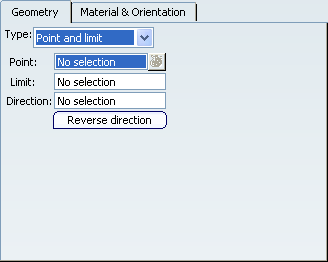
- Point
-
Select points where you want to create beams which appear in the Point box. You can do any of the following:
- Select the extremities of the existing beams. (The extremity nearest to your selection point is selected.)
- Select a point in your 3D session, or a point on the plane system grid. (Make sure that the Selectable Points check box is selected in the Plane System Grid dialog box.)
- Right-click the Point box and select Create Point to create a new point.
The icon
 is used to check the list of the selected points. You can replace or remove previously selected points using this icon and close the window.
is used to check the list of the selected points. You can replace or remove previously selected points using this icon and close the window. - Limit
- Select a plane in your 3D session to limit your beams, which appears automatically in the Limit box.
To select a plane from predefined plane system, right-click the Limit box, and choose Select Reference Plane.
Note: You can create a new plane to define the support using the Create Plane option.
- Direction
- Select a line or plane in your 3D session to define the direction for the beam which appears automatically in the Direction box.
To select a plane from predefined plane system, right-click the Direction box, and choose Select Reference Plane.
Note: You can create a new line or a plane to define the direction using other stack commands like Create Line, Create Plane.
Important: The Direction box displays XY plane as the default selection. - Reverse Direction
- Click Reverse Direction to change the orientation of the beams.
![]()
Point to Point
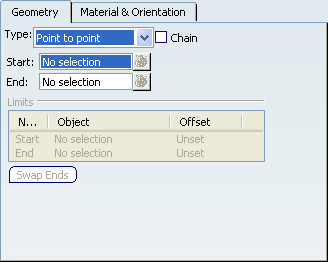
- Chain
- If you select the Chain check box, the last end point selected becomes the start point of the next beam.
- Start
-
Select a position along the support curve of an existing beam which appear automatically in the Start box. You can do any of the following:
- Select the extremities of existing beams. (When your selection point is near the start, mid, or end point of a beam, these points become your selection point. However, you can select specific offset values.)
- Select a point in your 3D session, or a point on the plane system grid. (Make sure the Selectable Points check box is selected on the Plane System Grid dialog box.)
- Right-click the Start box and select Create Point to create new point.
The icon
 is used to check the list of the selected points. You can replace or remove previously selected points using this option and close the window
is used to check the list of the selected points. You can replace or remove previously selected points using this option and close the window - End
- Select a position along the support curve of an existing beam which appear automatically in the End box. For more information, refer to the Start section above.
- Limits
- Select the start or the end to limit the placed beam which appear automatically in the Limits area. You can:
- Select an object in your 3D session (reference plane, plate, stiffener, beam or pillar), and the beam is limited at that location.
- Right-click to display a list and choose Select Reference Plane to display the Plane Systems dialog box. (You can select Delete Limit to delete a limit.)
- Enter a value in the Offset box to offset the beam from the limit. You can enter both negative (removes material) and positive (adds material) values.
When you define a limit, the Swap End button becomes available. You can click Swap End to invert the beam.
![]()
Curve
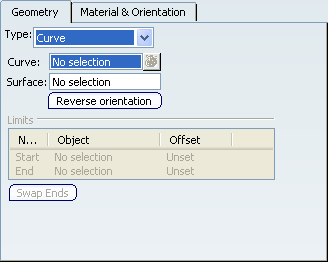
- Curve
- Select curves in your 3D session which appear automatically in the Curve box.
Note: You can create new curve using stack commands like Create Curve, Create Offset Curve, Create Line and Create Sketch.
The icon
 is used to check the list of the selected curves. You can replace or remove previously selected curves using this option and close the window
is used to check the list of the selected curves. You can replace or remove previously selected curves using this option and close the window - Surface
- Select surfaces in your 3D session which appear automatically in the Surface box.
Note: You can create a new surface using other stack commands like Create Plane, Create Loft or Create Fill.
Click Reverse Orientation to change the orientation of the beams.
- Limits
- Select the start and the end to limit the placed beam which appear automatically in the Limits area. You can:
- Select an object in your 3D session (reference plane, plate, stiffener, beam or pillar), and the beam is limited at that location.
- Right-click to display a list and choose Select Reference Plane to display the Plane Systems dialog box. (You can select Delete Limit to delete a limit.)
- Enter a value in the Offset box to offset the beam from the limit. You can enter both negative (removes material) and positive (adds material) values.
When you define a limit, the Swap End button becomes available. You can click Swap End to invert the beam.
![]()
Beams and Plane
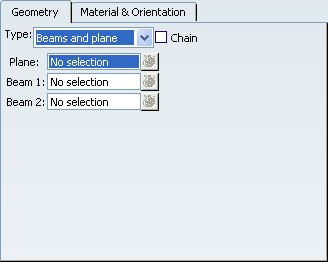
- Chain
- If you select the Chain check box, the last end point selected becomes the start point of the next beam.
- Plane
- Select a plane in your 3D session which appear automatically in the Plane box.
Note: To create new plane, right-click the Plane box, and select the Create Plane option.
- Beam 1
- Select a beam in your 3D session which appear automatically in the Beam 1 box.
- Beam 2
- Select a beam in your 3D session which appear automatically in the Beam 2 box.
The icon ![]() placed in front of Plane, Beam 1, Beam 2 boxes is used for listing the selected limits respectively. You can replace or remove previously selected limits using this option.
placed in front of Plane, Beam 1, Beam 2 boxes is used for listing the selected limits respectively. You can replace or remove previously selected limits using this option.
![]()
Reference Planes
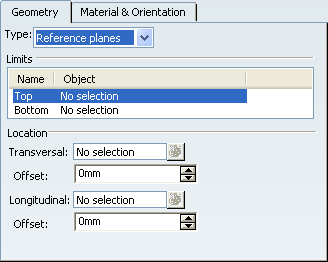
- Limits
-
Select top and bottom option to limit the beam which appear automatically in the Limits area. You can:
- Select an object (plate, stiffener, or plane) in your 3D session, and the pillar is limited at that location.
- Right-click to display a list and choose Select Reference Plane to display the Plane Systems dialog box. (You can select Delete Limit to delete a limit.)
The selected objects appear in the Object box.
- Location
- In the Location area, you can select transversal planes and longitudinal planes in your 3D session. They appear in the Transversal and Longitudinal boxes.
To select a plane from predefined plane system, right-click respective box, and choose Select Reference Plane.
Note: You can create a new plane to define the location using the Create Plane option.
You can enter an offset value (negative or positive) in the Offset box to offset the location in Transversal and Longitudinal boxes respectively.
The icon
 placed in front of Transversal and Longitudinal boxes is used for listing the selected limits respectively.
placed in front of Transversal and Longitudinal boxes is used for listing the selected limits respectively.You can replace or remove previously selected limits using this option and close the window.
![]()
Material and Orientation
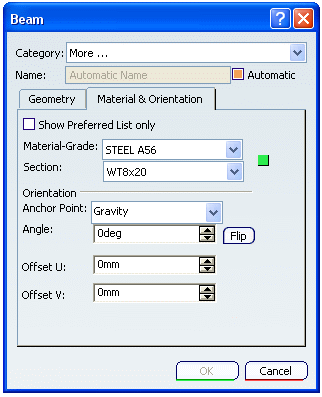
- Show Preferred List only
- Select this check box to show only recommended combination of material-grade and thickness.
Note: If the Material Table is not set in the Project Resource Management, then this option is unavailable.
- Material-Grade
- Select a material-grade from the list. Once you select a material, valid grades will be available for selection.
- Section
- Select a section in the Section list. A section is pre-selected based on your previous session. If you select More... in the list, then the Table Browser dialog box appears.
Note: The previously selected 10 sections are displayed in the Section list for quick selection.
Tip:
If the Material Table is set in the Project Resource Management, then a  or or  or or  will appear next to the Material-Grade and Section box. will appear next to the Material-Grade and Section box.This symbol indicates if the selected combination of material-grade and section is recommended or not.
|
| Important: If the Material Table is not set in the Project Resource Management, then you can select material-grade and section from the database. |
- Anchor Point
- Select the appropriate anchor point from the Anchor Point list to get the correct orientation of beam.
- Angle
- In the Angle box, type the value or use the arrows to change the value.This is the angle of rotation of the beam around the anchor point. Right-click the Angle box and select Change Step to change the value of the step. Click Flip to flip the section.
- Offset U
- In the Offset U box, specify the offset value in U direction.
- Offset V
- In the Offset V box, specify the offset value in V direction.